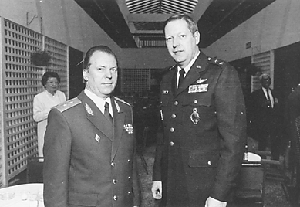| While
OSIA-Europe was planning and preparing to carryout CFE
Treaty inspections, the Threshold Test Ban Treaty and the
Peaceful Nuclear Explosions Treaty and their new
protocols entered into force on December 11, 1990.10 Within days both
parties began implementing the Threshold Test Ban Treaty.
The first step was the exchange of information on
national test sites and the number of scheduled nuclear
tests that would exceed 35 kilotons. Tests above that
level and below 150 kilotons were subject to verifying
inspections under the treaty. For 1991, the United States
declared that two of its nuclear underground tests at the
Nevada Test Site would fall within the TTBT's threshold
limits.11 The Soviet
Union declared that it would exercise its treaty rights
and monitor the tests. Initially, President Gorbachev
declared a limited moratorium on Soviet testing; however,
he changed that policy in June of 1991 and announced that
the Soviet Union would conduct two tests at its
Semipalatinsk nuclear test sites later in the year. The
United States promptly declared its intention to send
verification inspection teams to the USSR to monitor
those tests.12 For the On-Site Inspection Agency these announcements meant that the transition from planning and preparations to implementation was occurring rapidly. Implementing the Threshold Test Ban Treaty, like preparing for the Conventional Armed Forces in Europe Treaty, meant significant new responsibilities, requiring new people, resources, and funding, together with the necessity for considerable interagency coordination. |
 For the CFE Treaty, training included mock inspections in which American inspectors (blue jackets) played the role of the inspecting team, while the American escorts (battle dress uniforms) acted the part of the escorting team. |

